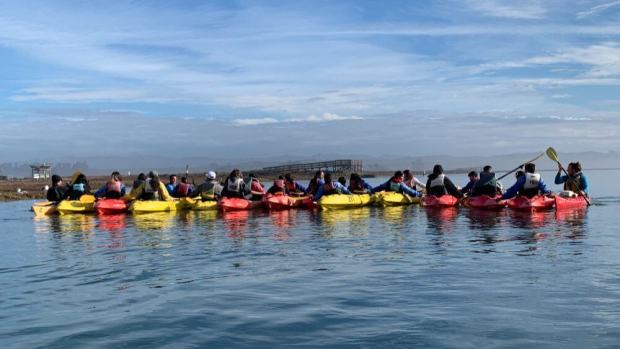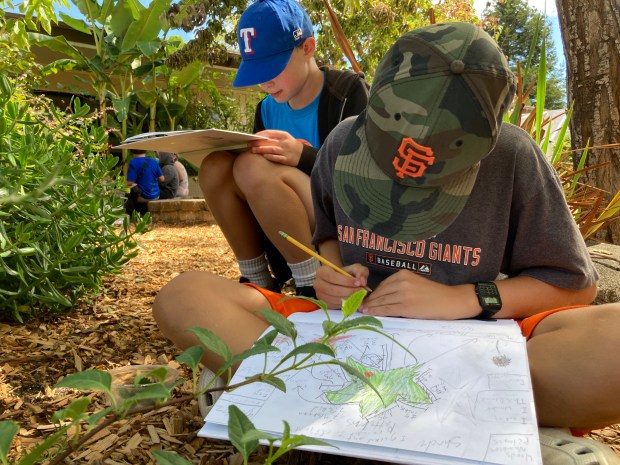
Blog: Finding Sanctuary – Students make waves to protect Monterey Bay National Marine Sanctuary By: Lisa Wooninck

Calabasas Elementary students participate in a kayaking field trip. (Laura Arnow/Contributed)
By: Lisa Wooninck
Published: Santa Cruz Sentinel, January 19, 2024
Students across the Monterey Bay and throughout the nation have been engaging in hands-on environmental stewardship projects, as part of NOAA’s Ocean Guardian School program.
With funding from NOAA’s Office of National Marine Sanctuaries, PreK–12 schools propose and implement a school or community based stewardship project around themes of watershed restoration, school garden/habitat, energy and ocean health, marine debris or the6Rs (Rethink/Reduce/Refuse/Reuse/Recycle/Rot).
Over the past 14 years, thousands of students have been immersed in Ocean Guardian environmental projects aimed at protecting their local watersheds, the world’s ocean, and special areas like national marine sanctuaries. “Eco-anxiety is a present-day issue affecting the next generation of ocean stewards,” says Seaberry Nachbar, Director of NOAA’s Ocean Guardian School program. “Youth across the country are experiencing a loss for what to do and how to deal with environmental catastrophes, which can leave many students feeling hopeless and overwhelmed. The Ocean Guardian School program helps mitigate these feelings by empowering students and teachers to take actions that positively impact our environment.”

Students at Santa Cruz Gardens Elementary take their science lessons outdoors for an immersive learning experience. (Carlo Albano/Contributed)
In Watsonville, Calabasas Elementary’s Green Team implemented a plastic litter program to reduce waste. Students lobbied for the installation of individual dispensers for utensils and napkins, which ultimately led to the school district eliminating single-use utensil packets. “Kids really hold the future in their hands,” says Laura Arnow, lead Ocean Guardian Schoolteacher at Calabasas Elementary school. “They have more power than they realize, and I wanted their voices to be heard. But first, they need to have something to say about what they want the grownups to do in order to protect their future. And for that to happen, they have to feel connected to a place, to nature, to the wonder and beauty that is so nearby. I wanted them to care first, and then to take action. The NOAA Ocean Guardian School program made it possible for us to pay for the tools we needed to make those connections.”
Plastic littered on our beaches or streets can make its way into the sanctuary and breakdown into microplastics. Students at Calabasas made the connection that our actions on land, like littering, ultimately make their way into the sanctuary and can have a tremendous impact on ecosystem health.
Students and teachers at Santa Cruz Gardens Elementary are currently utilizing their campus garden spaces to craft environmental solutions as part of their Science and Gardening Emphasis (SAGE) program. Through growing fruits and vegetables, studying lunchtime food waste, and diverting compostable food scraps from the landfill, students are able to help reduce their carbon footprint. “Our SAGE program is unique in that it cultivates a highly personal eco literacy within each student.” says Jade Giotta, Living Classroom Educator at Santa Cruz Gardens Elementary. “SAGE operates on the belief that students who grow up with their hands in the soil and a personal relationship to their local ecosystems will be more likely to be solutionary leaders with a 21st century skill.”
This past year alone, NOAA Ocean Guardian Schools across the nation removed 7,408square feet of non-native invasive plants; planted 331 native trees along with 4,370 native plants; removed a staggering 39,632 pounds of trash from neighborhoods and beaches; and81,637 pounds of food waste was diverted from local landfills.
Nachbar says: “These opportunities help students realize that changes they make in their daily lives can impact and safe-guard our one global ocean, including national marine sanctuaries and local watersheds. I’m so proud of the results we have seen through this program, which proves that empowering students gives hope for the future.” To join NOAA’s Ocean Guardian School program contact seaberry.nachbar@noaa.gov
Lisa Wooninck became the superintendent of NOAA’s Monterey Bay National Marine Sanctuary in 2021. She has a doctorate in ecology and evolutionary biology, and marine biology from UC Santa Barbara. She can be reached at lisa.wooninck@noaa.gov. To learn more about the sanctuary, visit https://montereybay.noaa.gov/.
